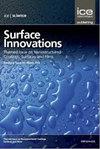Influence of forming directions on surface quality of 316L stainless steel produced by selective laser melting additive manufacturing
IF 3.5
4区 材料科学
Q3 CHEMISTRY, PHYSICAL
引用次数: 0
Abstract
Different forming directions have significant impact on surface quality in additive manufacturing. This study is aimed at exploring how different forming directions influence surface quality in additive manufacturing. First, experiments were designed to prepare 316L stainless steel by selective laser melting additives manufacturing in different forming directions. Besides, the surfaces of samples manufactured by additives manufacturing in different forming directions were tested using a 3D surface profiler and a scanning electron microscope. In this way, their 3D profile maps, surface roughness values, and scanning electron microscopy images were obtained. Furthermore, the surface quality was characterized by four parameters, the maximum height-S z , the maximum valley depth-S v , the standard deviation of height-S q , and the arithmetic average height-S a . The following results were obtained: (1) Different forming directions correspond to close upper surface roughness S a values, the minimum and maximum values of S a being 7.16 um and 8.20 um, respectively. S a is the smallest among the four parameters (S z , S v , S q , and S a ), shows good stability and statistical significance. (2) In the same forming direction, the upper surface roughness values follow S z >S v >S q >S a ,S z is the largest, exceeding 800 um, average value S a is the smallest reaching 7.36 um. The values of S q , S z , and S v vary when the forming direction changes; specifically, all of them increase when the forming direction changes from a vertical direction to planar and lateral directions in turn. (3) In different forming directions, the values of S z , S v , S q , and S a vary on different surfaces (XOY, YOZ, and XOZ surfaces), but their variations are basically similar. Meanwhile, the S z , S v , S q , and S a values of the free surfaces are at least 10 times greater than those of the printed surface. (4) In the selective laser melting additive manufacturing process, it is necessary to reasonably select a forming direction for parts with different dimensional parameters on each side. High-quality workpiece can be obtained with a reasonable forming direction. The proposed method serves as references for the selection of forming direction of selective laser melting additive manufacturing and provides a new method to improve the surface quality of parts by additive manufacturing.成形方向对选择性激光熔化增材制造316L不锈钢表面质量的影响
在增材制造中,不同的成形方向对表面质量有显著影响。本研究旨在探讨增材制造中不同成型方向对表面质量的影响。首先,设计了采用不同成型方向的选择性激光熔化添加剂制备316L不锈钢的实验。此外,利用三维表面轮廓仪和扫描电镜对不同成型方向的添加剂制备样品进行了表面形貌测试。通过这种方法,获得了它们的三维轮廓图、表面粗糙度值和扫描电镜图像。地表质量由最大高度- s z、最大谷深- s v、高度标准差- s q和算术平均高度- s a 4个参数表征。结果表明:(1)不同的成形方向对应的上表面粗糙度S a值较为接近,S a最小值为7.16 um,最大值为8.20 um;S a在S z、S v、S q、S a四个参数中最小,具有较好的稳定性和统计学意义。(2)同一成形方向上表面粗糙度值依次为S z >S v >S q >S a,S z最大,超过800 um,平均值S a最小,达到7.36 um。S q、S z、S v随成形方向的变化而变化;其中,当成形方向由垂直方向依次向平面方向和横向方向转变时,它们都有所增加。(3)在不同成形方向下,不同表面(XOY、YOZ、XOZ)上的S z、S v、S q、S a值不同,但变化基本相似。同时,自由表面的sz、sv、sq和sa值至少是印刷表面的10倍。(4)在选择性激光熔化增材制造工艺中,需要对每侧尺寸参数不同的零件合理选择成型方向。合理的成形方向可以得到高质量的工件。该方法为选择性激光熔化增材制造成形方向的选择提供了参考,为增材制造提高零件表面质量提供了一种新方法。
本文章由计算机程序翻译,如有差异,请以英文原文为准。
求助全文
约1分钟内获得全文
求助全文
来源期刊

Surface Innovations
CHEMISTRY, PHYSICALMATERIALS SCIENCE, COAT-MATERIALS SCIENCE, COATINGS & FILMS
CiteScore
5.80
自引率
22.90%
发文量
66
期刊介绍:
The material innovations on surfaces, combined with understanding and manipulation of physics and chemistry of functional surfaces and coatings, have exploded in the past decade at an incredibly rapid pace.
Superhydrophobicity, superhydrophlicity, self-cleaning, self-healing, anti-fouling, anti-bacterial, etc., have become important fundamental topics of surface science research community driven by curiosity of physics, chemistry, and biology of interaction phenomenon at surfaces and their enormous potential in practical applications. Materials having controlled-functionality surfaces and coatings are important to the manufacturing of new products for environmental control, liquid manipulation, nanotechnological advances, biomedical engineering, pharmacy, biotechnology, and many others, and are part of the most promising technological innovations of the twenty-first century.
 求助内容:
求助内容: 应助结果提醒方式:
应助结果提醒方式:


